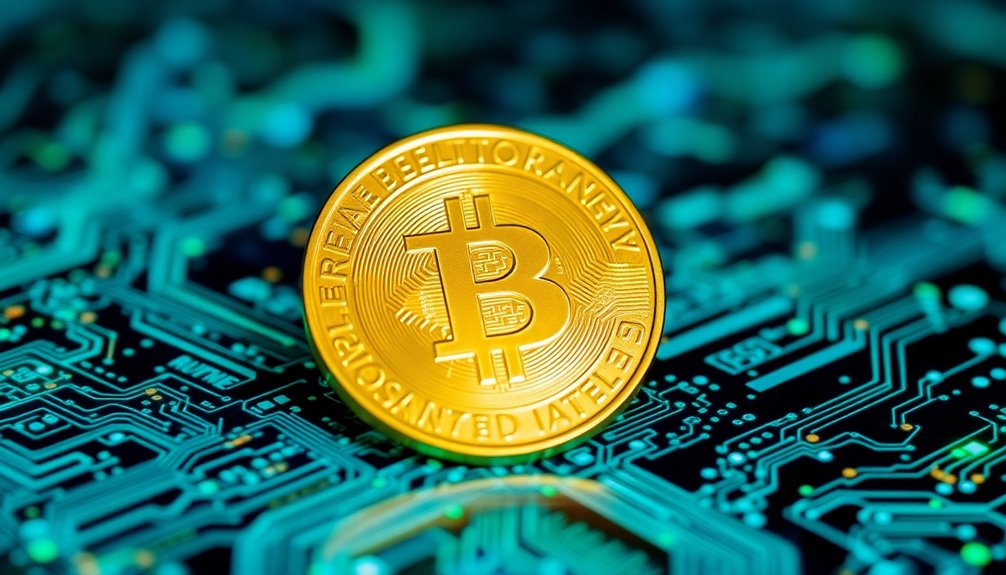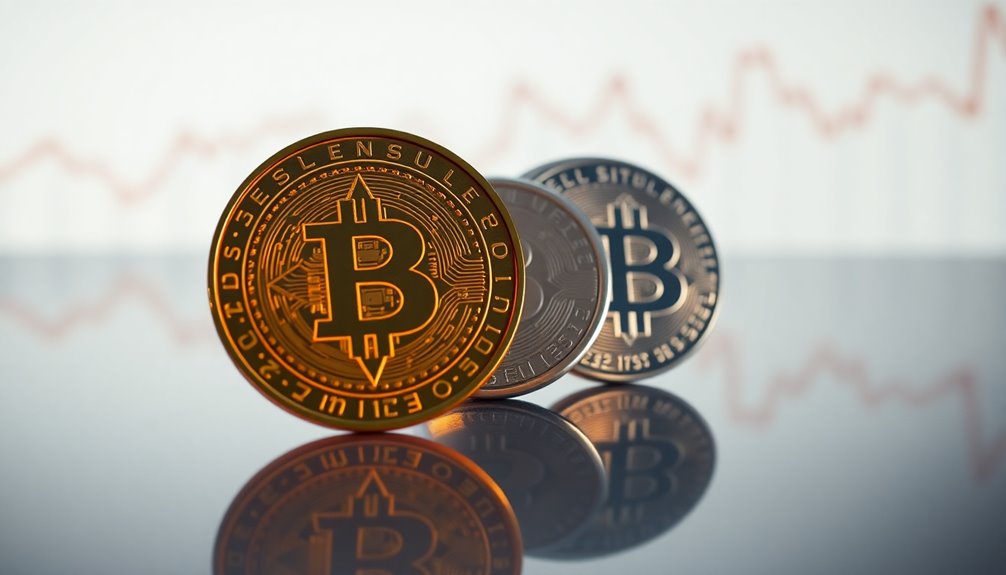RUNE is the native utility token within the THORChain ecosystem, designed to facilitate cross-chain asset swaps and liquidity pooling. You'll use RUNE for transaction fees and to participate in governance decisions that shape the network. As a liquidity provider, you can earn rewards from swap fees proportional to your contributions. The capped supply of RUNE enhances its value within this user-driven ecosystem. While RUNE has seen some market volatility recently, its unique features make it an intriguing option for those looking to navigate the DeFi landscape. Find out what more you can achieve with RUNE in this expanding market.
Key Takeaways
- RUNE is the native utility token of the THORChain ecosystem, facilitating cross-chain asset exchanges.
- It enables governance, allowing token holders to influence network decisions and development.
- RUNE serves as an intermediary asset for seamless swaps without needing wrapped tokens.
- Liquidity providers earn rewards from transaction fees proportional to their contributions in liquidity pools.
- The current circulating supply of RUNE is approximately 347.5 million, with a market cap of around $1.1 billion.
Core Functionalities of RUNE

RUNE plays a crucial role in the THORChain ecosystem, serving multiple essential functions that enhance its utility and value.
As the native utility token, RUNE enables governance, allowing holders to influence decisions within the network. It's vital for transaction fees and acts as the intermediary asset for swaps, making cross-chain transactions seamless without the need for wrapped tokens.
Liquidity providers rely on RUNE to earn rewards and swap fees by contributing to liquidity pools.
With an initial supply of 1 billion, it was reduced to 500 million, and the current circulating supply is about 347.5 million. Priced at around $3.06, RUNE's market cap hovers around $1.1 billion, reflecting its market dynamics and volatility.
Overview of Rune's Ecosystem

As you explore THORChain's ecosystem, you'll discover a dynamic network designed for seamless cross-chain asset exchanges.
RUNE, the native token of THORChain, underpins this decentralized liquidity protocol, enabling cross-chain swaps across blockchains like Bitcoin and Ethereum.
Utilizing automated market maker (AMM) technology, you can deposit into liquidity pools to earn yield without needing wrapped tokens. RUNE also mitigates impermanent losses through its slip-based fee system, enhancing your experience as a liquidity provider.
Moreover, THORChain features a governance model that empowers RUNE holders to influence its development and operational direction.
With a capped supply of 1 billion RUNE, the protocol's design fosters a robust and user-driven ecosystem.
Liquidity Pooling Mechanics

While exploring the mechanics of liquidity pooling within THORChain, you'll find that continuous liquidity pools (CLPs) play a pivotal role in facilitating seamless asset swaps across various blockchains.
RUNE serves as the native pairing token, acting as an intermediary for these transactions. By depositing assets into CLPs, liquidity providers earn swap fees, which are proportional to their share of the pool.
The slip-based fee system helps minimize impermanent losses, allowing you to retain more of your investment value. You can also engage in single-sided liquidity provision through Savers Vaults, letting you earn fees while diversifying your risk.
This decentralized exchange approach enhances cross-chain liquidity, making asset swaps more efficient and accessible.
Liquidity Provider Rewards

When you participate as a liquidity provider on THORChain, you can earn rewards through the swap fees generated from trades in your liquidity pools.
These fees are distributed proportionally based on your share of the total liquidity pool, meaning the larger your contribution, the greater your potential earnings.
As you accumulate rewards, your RUNE holdings increase, providing a direct incentive for your participation.
THORChain also offers Savers Vaults, allowing you to earn rewards without direct exposure to RUNE fluctuations.
The platform's fee structure is designed to minimize impermanent loss, making it a more attractive option for liquidity providers.
With active trading activity, you can enhance your earnings while contributing to the overall ecosystem's liquidity.
RUNE vs. Other Liquidity Tokens

RUNE stands out among liquidity tokens primarily because it facilitates seamless cross-chain swaps without relying on wrapped tokens, allowing you to trade native assets directly.
Unlike many liquidity tokens, RUNE supports single-sided liquidity provision through Savers Vaults, significantly reducing your exposure to impermanent losses. It serves as the essential intermediary for trades within the THORChain ecosystem, linking various liquidity pools efficiently.
With a total supply capped at 1 billion and a circulating supply of approximately 347.5 million, RUNE's scarcity enhances its value compared to inflationary counterparts.
While RUNE's market performance has shown significant volatility, currently priced at $3.06, this contrasts with other liquidity tokens that tend to have more stable price histories, making RUNE a unique option for liquidity providers.
Market Volatility Impact

The volatility in RUNE's price can significantly impact your investment strategy and decision-making.
With a current price reflecting a decline of 33.64% over the year, you'll notice that market prices are maintained by trading volume of THORChain, which has also faced significant fluctuations.
RUNE tokens have dropped by 53.2% in the past month alone, emphasizing ongoing challenges. As a liquidity provider, you can experience the repercussions of this instability firsthand.
The market cap for RUNE currently stands at $1.1 billion, and it's underperforming by 64.95% compared to the broader market.
Keeping an eye on these trends will help you navigate your investments in this volatile landscape and adjust your strategy accordingly.
Emerging Defi Partnerships

As THORChain explores partnerships with emerging DeFi projects, it aims to enhance cross-chain liquidity solutions and expand its ecosystem.
By collaborating with platforms focused on lending, yield farming, and decentralized exchanges, RUNE is positioned as a vital liquidity and governance token for various financial services.
These recent partnerships include the integration of new decentralized applications (dApps), making seamless swaps and access to multi-chain assets easier for users.
THORChain's community-driven approach encourages proposals that align with its mission of decentralized trading and liquidity provision.
Additionally, continuous updates and features, such as Streaming Swaps, attract DeFi partnerships eager to leverage THORChain's unique cross-chain functionalities for enhanced user experience and diversified asset management.
Utilize Stop-Loss Orders

When navigating the unpredictable waters of the crypto market, employing stop-loss orders can be a smart strategy for safeguarding your investments in RUNE.
These risk management tools allow you to set a predetermined price at which your RUNE holdings will automatically sell, helping to mitigate losses during periods of high volatility.
For instance, with RUNE's recent price drop of 37.11% and a staggering 53.2% decrease over the past month, stop-loss orders can protect your investments effectively.
You can customize your stop-loss thresholds based on your risk tolerance, ensuring you exit positions before hitting critical support levels.
Given RUNE's current price of $3.06, using stop-loss orders is essential for managing your investments in this volatile crypto market.
Frequently Asked Questions
What Is RUNE Crypto Used For?
RUNE's primarily used for governance within the THORChain ecosystem, letting you vote on protocol upgrades and changes.
You'll also find it essential for liquidity pools, as it enables seamless swaps between cryptocurrencies without needing wrapped tokens.
Plus, RUNE covers transaction fees, incentivizing liquidity providers and keeping the network running smoothly.
Is RUNE a Good Investment?
Can you handle the thrill of potential gains? RUNE's recent drop might give you pause, but its market cap and utility within the THORChain ecosystem are compelling.
With a solid circulating supply and the all-time high hinting at speculative interest, you could see significant returns if the platform expands.
Plus, its interoperability might unlock arbitrage opportunities. Weigh the risks, but don't overlook RUNE's potential as a bold investment move.
Can RUNE Reach $100 Dollars?
You might wonder if RUNE can reach $100. Achieving that price would necessitate a massive increase in market demand and adoption, considering its current market cap and recent performance.
While RUNE's unique features could drive future interest, the market's volatility and a 33.64% decline over the past year make such a target uncertain.
Keeping an eye on market trends and user adoption will be crucial in evaluating RUNE's potential for substantial growth.
What Is RUNE Used For?
RUNE's primarily used for facilitating transactions within the THORChain ecosystem.
You'll find it essential for pairing in liquidity pools, making cross-chain swaps possible. If you hold RUNE, you can stake it to earn yields while contributing to network security.
You'll also use it for transaction fees, which help sustain the protocol economically. Plus, as a RUNE holder, you can participate in governance, influencing upgrades and features that shape the network's future.
Conclusion
In the ever-evolving landscape of crypto, RUNE stands as a beacon for liquidity and decentralized finance. Just like the legendary heroes of myth, it empowers you to navigate the turbulent seas of market volatility with confidence. By participating in its ecosystem, you're not just a bystander; you're part of a movement reshaping finance. So, harness the power of RUNE, explore new partnerships, and don't forget to utilize stop-loss orders to shield your investments.








